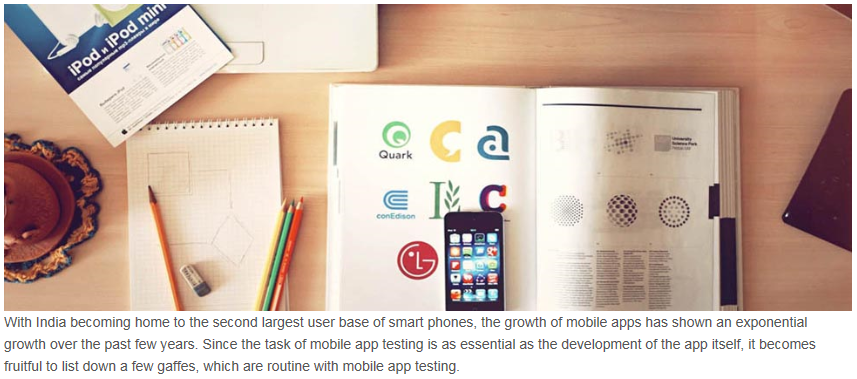
20
Oct
Mobile app testing mistakes you must avoid
1. The looks are important, but then so are the uses:
Mobile app testers often tend to focus more on the UI/UX aspect of the app and forget about the basic functionality for which the app was developed in the first place! An app is only as good as its use. Agreed an eye catching user interface always attracts more users, but if it fails in providing solutions, then it's nothing more than a dud. Therefore a balance perspective with equal focus on UI and functionality is the need of the hour.
2. Jumping to test without knowing the Sophistication involved:
More of an attitudinal thing than a flaw, it's common to find testers run through the process of testing without arming themselves with a thorough understanding of the basic working logic in the app. A couple of tests on the UI, some feature tests here and there and ta da the report is ready for submission. Important thing before testing is to have requisite knowledge of the chief functionality, user end requirements, a vision for changes expected at the end of an update, the business requirements from the app, etc. This will eventually help in developing a wide coverage for all the intricacies in need of testing.
3. Web and mobile testing are as different as chalk and cheese:
To someone who is familiar with the world of web page testing, the approach to mobile app testing may sound similar. However, the two things are a world apart. While an average web browser may require an update once a year at the most, a mobile application requires a visit to the app store virtually every month. Therefore, a mobile app tester requires to incorporate an approach which will validate the functionality of an app in sync with its scheduled updates.
4. Online/offline plus networking issues:
While it is crucial to test the proper working of the app when the user is online and offline, a vital issue often overlooked, is its ability to work across different bandwidths. This becomes relevant for users residing in areas having a history of intermittent service provision of net/ wireless capabilities.
5. Utility of Crash logs:
Crashes are major irritants for users and one of the biggest factors contributing to a lower rating of the app. Hence, it pays to maintain a detailed report of all the crash occurrences, so that it becomes convenient for the tester to prioritise all the major bug issues and prevent them happening post lunch.
6. We can test everything:
It goes beyond the realm of possibility to test, say 100 case scenarios for an app, over 10 different devices, operating under 10 diverse working environments. The problem is compounded when the date for the launch of the app is ever so near. Common sense advocates prioritising a few critical test case scenarios based on recent market trends for devices which are most in vogue, studying user behaviours and making use of google analytics.
7. Inadequate reporting of bugs:
Due to miscommunication, inadequate knowledge or time constraints related to launch deadlines, the testers are not able to send a complete report of all the repetitive and critical bus which hampers an app's working and consequently the developer team is unable to resolve all the issues cropped up at the time of testing. As a result, the app is released into the market replete with glitches.
8. Complexity in the name of sophistication:
Many users find it difficult to navigate their way in an app because of a congested or sophisticated user interface. Therefore, it pays to have an app that is easy on the eye for the customers and moreover, the test cases involved for such interfaces is always easy and less time consuming.
9. One tester can do it all:
It is always beneficial to have professionals having experience in working on different environments on your team. By tapping into their knowledge, a greater number of potential flaws in the app can be detected at half the time, before the pending launch.
10. Importance of customer feedback:
You have tested the app and it has been launched and your work is over, right?, not quite. The tester must make it a point to gaze through the user reviews for the products similar to the ones he tested. These are readily available at app stores such as Google play store, Mobogenie, etc.
The ubiquity of a smart phone is testament to the fact, our lives will now be increasingly be controlled by mobile apps. The importance of mobile testing can thus never be overemphasized.
Referance: http://www.thinksys.com/mobile-app-testing-mistakes-you-must-avoid.shtml
February 17, 2016
- ThinkSys Team